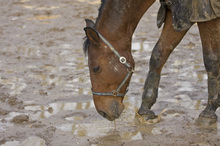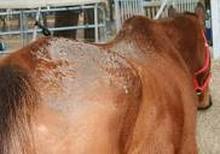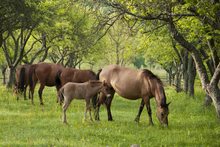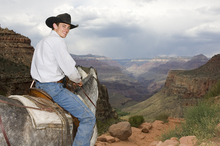
As the snow pack melts across much of North America, horse owners look forward to riding outside and and the prospects of lush green grass. Unfortunately, mud season must be survived first!
Here are our first 5 tips to get you and your horse through spring and heading into summer in great shape.
Tip #1. Think feet!
With spring your horse will be left standing on wet ground, in mud puddles and in water at least part of the time he is outside in a turnout of any kind.
While there are horses with hard, dry hoofs that benefit from some wet terrain, these conditions open up the average horse to infections like thrush.

Wet ground + mud = hoof problems
With snow melting and spring-time rain storms arriving, your horse may be standing in mud puddles during turnout time.
Thrush is an infection of the hoof - mainly around and involving the frog - caused by the anaerobic bacteria, Fusobacteriumnecrophorum. Anaerobic means this bacteria grows best in conditions without oxygen.
What you will see, or even more likely smell, is a very stinky black buildup in the crevices by the frog.
Luckily, thrush responds well to topical treatment. Copper solutions are often used to treat this condition by pouring some liberally on the area after carefully cleaning the hoof out.
Up the quality of your husbandry too. Make sure your horse has a clean, dry stall to hang out in at least part of every day, so his hoofs dry out.
Daily hoof cleaning is better yet. Twice daily is important for preventing thrush and keeping horse's hoofs healthy.
Tip #2. Pay attention to legs
Move up the leg a little from the hoof and now you find 'scratch' on the heel bulbs and in the pasterns. Early on, the heels and pastern may be reddened, warm, and ooze a small amount of yellowish, watery liquid (serum).
As the condition progresses, hair is lost, the area becomes thickened, and hard crusts or scabs of serum form. The condition is painful to the touch and may even cause the horse to become lame
Since chronically wet and muddy skin loses some of its potency as a barrier to infection. Bacteria such as Dermatophilus congolensis and some Staphylococcus species, as well as a variety of fungal organisms take advantage of the rain softened skin to move in causing strange-looking scruffy patches or bald spot on your horse's skin.
Did you know:
Scratches is a relatively common skin disease of the heels and back of the pastern. Also known as "greasy heel," and "mud fever," veterinarians may refer to it as "pastern dermatitis" or "pastern folliculitis."
Initially this is a mild dermatitis, which responds to cleaning and drying the area thoroughly daily. If left untreated, the infection can develop and move up the leg and/or deeper into the tissues. You may need to trim the feathers off the fetlock to allow for easier and more thorough cleaning as well as faster drying.
A variety of astringents and medicated creams have been used to treat scratches or mud heel as it is sometimes called. Severe cases may need antibiotics.
The ideal is to avoid developing this problem to begin with. Try to provide your horse with some dry islands or sheltered places in his turnout area if it tends to be wet. Make sure he has time every day in a dry, clean stall.
Faithfully wash and groom those areas daily if at all possible. Then apply medications as needed after you have dried the area.
Tip #3. Beware wet body conditions
The third member of the wet-horse problem trio is rain rot or rain scald. Caused by that pesky bacteria Dermatophilus congolensis, this time your horses develops lesions on the neck and back.

A horse with rain rot
When your horse's skin is chronically wet, the skin loses its defenses against bacteria and fungi leaving it open to conditions such as rain rot.
© 2015 by EcoEquine
When your horse rolls in mud and also spends time outside with rain pouring down on his skin, defenses are lowered. This bacterium, which is found in soil, can be spread by insects and can infect the skin.
Horses with heavy winter coats who have not shed out can hold moisture in their coats for quite a while after a good soaking. This makes perfect conditions for this problem.
You may feel this condition as easily as you can see it. If you run your hand over your horse's rump you will feel raised areas that are patches of hair with scabs beneath.
Removing the scabs will reveal small areas of pus. Luckily rain rot will usually clear on its own with warm, dry weather and some sunshine.
Careful grooming, as the area may be painful, and a bath followed by thorough drying will hasten the healing of the lesions. Be sure to disinfect any grooming tools and don't share grooming tools with other horses.
Tip #4. Caution: Lush green pastures ahead!
April showers do bring May flowers and also lush new grass. Grass is a welcome change from mud, but lush pastures require some caution on your part.

Pasture turnout time - Use caution
Horses coming off eating hay all winter are poorly adapted to switch to grass with its higher levels of starches such as fructans.
Any equines who have metabolic syndrome or are insulin resistant need limited pasture time. This includes most donkeys and miniature horses as well as some full size horses.
Horses coming off eating hay all winter are poorly adapted to switch to grass with its higher levels of starches such as fructans. These starches build up in grass all day and then are used by the plants overnight.
Therefore, your best bet is to introduce your horses to grazing primarily in the morning at first and for limited periods of time.
Problems that can arise from too much spring grass include diarrhea, colic and founder or laminitis. You can avoid these serious illnesses by limiting grazing time and also continuing to feed some hay.
If you know your horse will be outside for long periods of time, consider a grazing muzzle or using a dry lot for part of the time.
Tip # 5. Gradual conditioning pays off
As snow banks recede and warm sun shines down, the urge to work your horse and start competing is almost overwhelming. It is important to remember to gradually condition your horse if he has been off for all or part of the winter.

Horse and rider taking advantage of spring-time weather
Riding your horse over changing terrain by going up and down hills promotes fitness and conditioning in horses.
Riding in an arena is no substitute for hacking up and down hills and on long trails. In addition if you took time off, you need to condition muscles to flex and extend. Doing this slowly is much better for your horse than a crash course.
Stamina is another area you will need to work on. Many horsemen swear by interval training. Believed to have been developed in ancient times to condition chariot horses, interval training is best known in the eventing and endurance worlds where great stamina is required for success.
Interval training can be tailored to develop greater stamina and endurance in any horse whether an outstanding competitive equine or a pleasure horse used mainly for trail riding or other activities.
An important part of any type of conditioning program is the warm-up period preceding each workout. This time is crucial to raise the horse's body temperature, increase blood flow to working muscles, and minimize chances for exercise-related injuries.
Build warm ups and cool downs into your exercise regimens. Look at your horse's health care needs and be prepared to adjust his diet as needed with increased work.
Whatever method you use for conditioning and developing fitness in your horse, slow but sure is again the ideal plan.
Where are tips 6 - 10?
Be sure to come back for Part 2 with tips 6 - 10.
